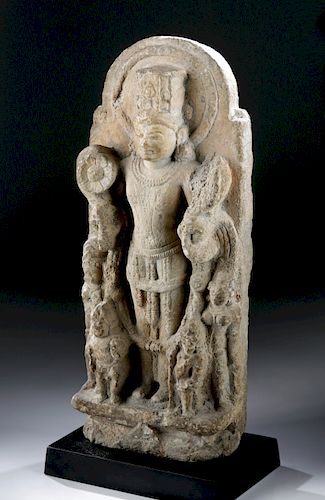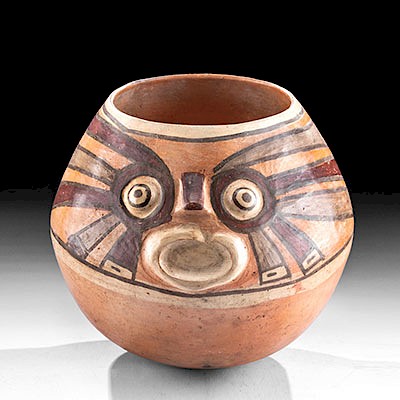11th C. Indian Schist Stele of Krishna / Vishnu
Lot 60b
About Seller
Artemis Gallery
686 S Taylor Ave, Ste 106
Louisville, CO 80027
United States
Selling antiquities, ancient and ethnographic art online since 1993, Artemis Gallery specializes in Classical Antiquities (Egyptian, Greek, Roman, Near Eastern), Asian, Pre-Columbian, African / Tribal / Oceanographic art. Our extensive inventory includes pottery, stone, metal, wood, glass and textil...Read more
Categories
Estimate:
$5,000 - $8,000
Absentee vs Live bid
Two ways to bid:
- Leave a max absentee bid and the platform will bid on your behalf up to your maximum bid during the live auction.
- Bid live during the auction and your bids will be submitted real-time to the auctioneer.
Bid Increments
| Price | Bid Increment |
|---|---|
| $0 | $25 |
| $300 | $50 |
| $1,000 | $100 |
| $2,000 | $250 |
| $5,000 | $500 |
| $10,000 | $1,000 |
| $20,000 | $2,500 |
| $50,000 | $5,000 |
| $100,000 | $10,000 |
| $200,000 | $20,000 |
About Auction
By Artemis Gallery
Dec 5, 2019
Set Reminder
2019-12-05 10:00:00
2019-12-05 10:00:00
America/New_York
Bidsquare
Bidsquare : Ancient / Ethnographic - Holiday Edition
https://www.bidsquare.com/auctions/artemis-gallery/ancient-ethnographic---holiday-edition-4710
What to give this holiday season? Ancient & Ethnographic Art of course! Our special Holiday auction features hundreds of unique finds from all over the world. Artemis Gallery info@artemisgallery.com
What to give this holiday season? Ancient & Ethnographic Art of course! Our special Holiday auction features hundreds of unique finds from all over the world. Artemis Gallery info@artemisgallery.com
- Lot Description
Central Asia, India, Rajasthan, ca. 11th century CE. A finely carved schist stele of an overall arched form and presenting Krishna - an avatar of Vishnu - standing and holding attributes in both hands - a lotus blossom in his right hand and what appears to be a shankha - a sacred shell and symbol of Vishnu - in his left hand. Krishna wears an elaborately bejeweled dhoti and is draped with a floral garland, his visage delineated with strong features and topped by a high crown. The deity is flanked by two female and two male attendants who are delineated in a much smaller scale, perhaps to indicate the elite status of Krishna. Size: 9.75" W x 23.625" H (24.8 cm x 60 cm); 25.375" H (64.5 cm) on included custom stand.
Krishna is one of the major deities of Hinduism, an avatar of Vishnu, god of compassion, tenderness, and love. The Middle Kingdoms period - a period with a multitude of rulers and kingdoms across the subcontinent - was part of the era of classical Hinduism dating from ca. 200 BCE to 1100 CE. Artwork made during this period must be understood as deeply ritual and spiritual. This piece, created at the end of this period, was likely intended as a decoration in the wall of a temple or palace. Imagine entering a place decorated with a multitude of finely carved deities like this example!
Provenance: private New York, New York, USA collection; ex-private lifetime collection of Dr. Saul Tuttman and Dr. Gregory Siskind, New York, New York, USA, collection number 158, acquired from Steve Gano, Art Asia Gallery, New York, USA, January 1967
All items legal to buy/sell under U.S. Statute covering cultural patrimony Code 2600, CHAPTER 14, and are guaranteed to be as described or your money back.
A Certificate of Authenticity will accompany all winning bids.
We ship worldwide and handle all shipping in-house for your convenience.
#147734Expected age wear with chips to peripheries and high-pointed areas. Normal surface wear commensurate with age. Earthen deposits and scattered mineral deposits grace the surface. Verso is uncarved and shows an area of loss that does not jeopardize the integrity of the piece as well as a handwritten collection number.Condition
- Shipping Info
-
All shipping is handled in-house for your convenience. Your invoice from Artemis Gallery will include shipping calculation instructions. If in doubt, please inquire BEFORE bidding for estimated shipping costs for individual items.
-
- Buyer's Premium



 EUR
EUR CAD
CAD AUD
AUD GBP
GBP MXN
MXN HKD
HKD CNY
CNY MYR
MYR SEK
SEK SGD
SGD CHF
CHF THB
THB














